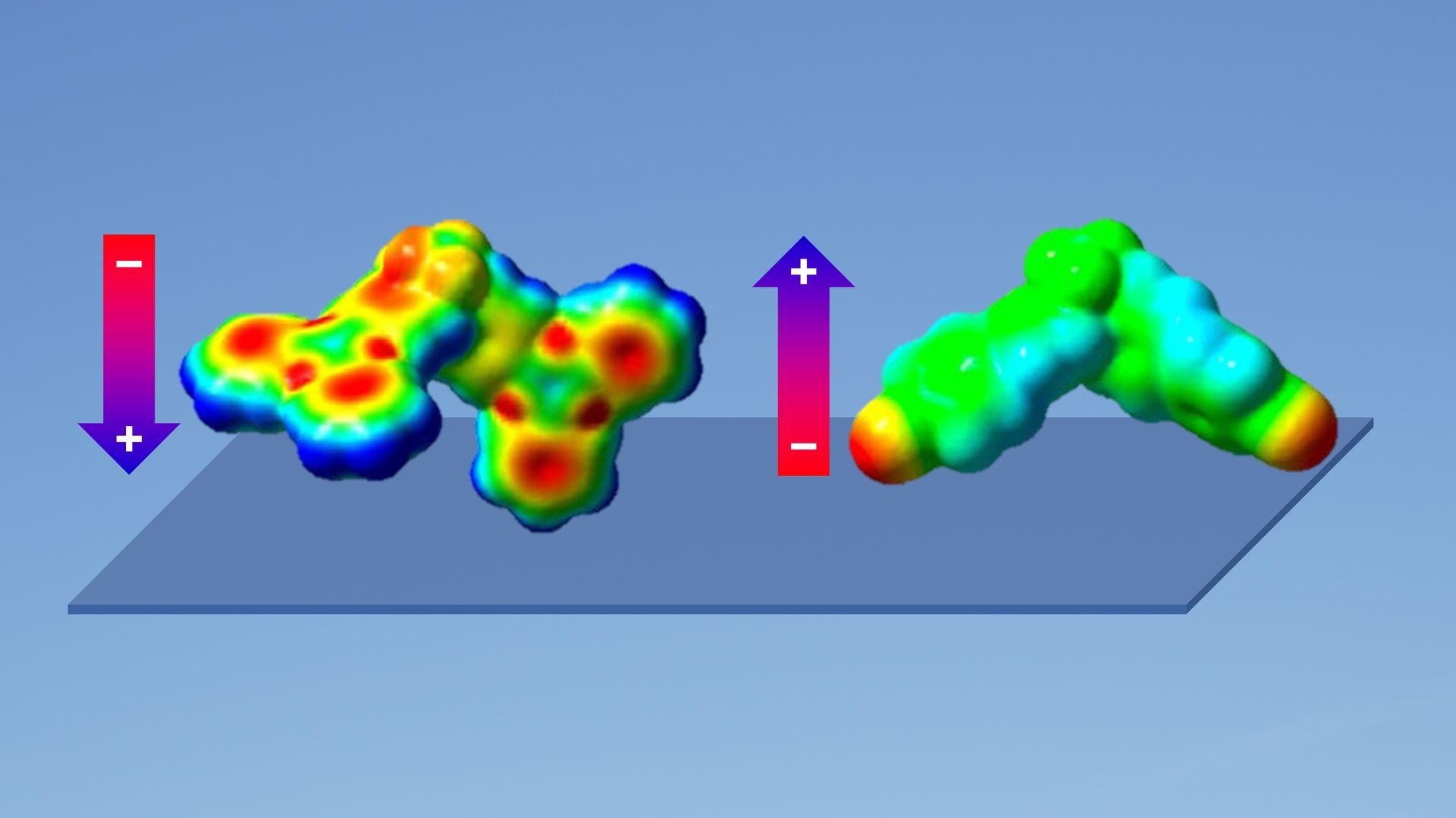Scientists at Kyushu University have constructed a succession of molecules that prefer to head the same direction when evaporated onto a surface.

This figure shows two molecules that spontaneously align on a surface to generate controlled electric fields, with red indicating areas of more negative charge and blue areas of less negative charge. Although the common unit in the middle generally aligns away from the surface, the different surrounding units result in positive or even negative fields at the surface. Image Credit: Kyushu University.
Scientists want to use the method to generate controlled electric fields that will aid in the effectiveness of organic light-emitting diodes used in displays and lighting, as well as open up new avenues for creating devices that transform vibrations into electricity using organic materials.
Organic electronics, which are based on the incredible chemical adaptability of carbon that allows living beings to exist, are already powering a wave of vibrant—and potentially flexible—smartphone and TV screens, with applications such as solar cells, lasers, and circuits on the horizon.
The uneven character of the thin layers of the materials utilized in the devices contributes to this flexibility. Organics typically create ‘amorphous’ layers that are not quite as neatly ordered as standard inorganic electronics, which are based on silicon atoms securely bonded in hard, well-organized crystals.
Despite the molecules’ seeming random structure, studies have identified that some of them tend to connect in similar directions, drastically influencing device attributes and opening up new avenues for managing device performance.
Significant work has already been done on molecules that align in a way that the light they emit can more easily escape a device.
Masaki Tanaka, Assistant Professor, Tokyo University of Agriculture and Technology
Tanaka began his work at Kyushu University’s Center for Organic Photonics and Electronics Research (OPERA) and resumed his research on molecular alignment in amorphous films after moving to TUAT.
“However, other molecules were known to align in a way that puts more of their electrons on one side of the layer, leading to a so-called surface potential accompanied by an electric field. This field can help charges move into or out of a device to make it more efficient or unlock new electrical properties, but finding ways to control the formation of the field has been a challenge,” Tanaka says.
Films used in organic electronics are typically tens of nanometers thick—a fraction of the thickness of a human hair—and are frequently built up slowly by first warming an organic powder in a vacuum so that it directly converts from a solid to a gas—a process called as sublimation. When molecules of the sublimed powder meet a cool surface, they bind together to create a layer.
“In the gas phase, the molecules are randomly rotating and bumping into each other, so they are likely to deposit in a random direction on a film,” clarifies Morgan Auffray, who synthesized the molecules.
“However, we found that certain molecular units with fluorine atoms will repel away from the deposition surface. By including these units in a molecule, we can get the deposited molecules to roughly align, with the fluorinated units facing out,” Auffray says.
After that, the researchers added components that push and pull negatively charged electrons toward and away from the fluorinated unit. This voltage difference across matched molecules on a surface produces the surface potential and the accompanying electric field.
Since the deposited molecules and their associated electric fields point in a similar direction, the individual tiny fields add up to produce a much larger overall field. Not only can we get a relatively larger field, but we can get it to point toward the surface, which has been rarely reported so far.
Masaki Tanaka, Assistant Professor, Tokyo University of Agriculture and Technology
These layers provide a massive surface potential of approximately 10 V, which is especially astounding given that it was produced naturally by a film only 100 nm thick.
One such high voltage within such a thin layer generates a strong electric field, which can help get positive and negative charges into the different layers of electronics like OLEDs, enhancing the overall efficiency of power conversion.
Moreover, these regulated, built-in electrical structures may help in the development of new gadgets. The layers have already been shown to be useful in a novel sort of device that turns vibrations into electricity, but more work is needed to make these devices viable.
“Science keeps showing us new ways to control electrical processes on a smaller and smaller scale by arranging atoms in organic molecules. This research adds to our tool bag, which will make new devices possible as it continues to grow,” says Chihaya Adachi, director of OPERA.
Journal Reference
Tanaka, M., et al. (2022) Spontaneous formation of metastable orientation with well-organized permanent dipole moment in organic glassy films. Nature Materials. doi.org/10.1038/s41563-022-01265-7.